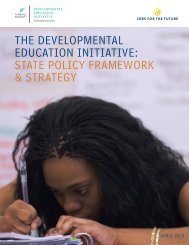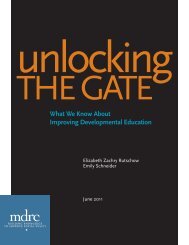Preparing High School Students for College - ERIC - U.S. ...
Preparing High School Students for College - ERIC - U.S. ...
Preparing High School Students for College - ERIC - U.S. ...
- No tags were found...
Create successful ePaper yourself
Turn your PDF publications into a flip-book with our unique Google optimized e-Paper software.
programming and create a more cost-effective system. If new and better-aligned collegereadiness programming does, in fact, result in better postsecondary outcomes <strong>for</strong> students, itwould be valuable to know the costs of achieving these impacts. Cost-effectiveness studiescan provide in<strong>for</strong>mation about the relationship between positive student outcomes and theirassociated costs, and they may reveal whether these programs produce longer-term payoffs.Considering the Use of IntermediariesIn some of the programs we researched, the creation or coordination ofprogramming across secondary and postsecondary institutions was facilitated by theinvolvement of a third party. Because they are not bound by K-12 or higher educationdesignations, external partners can contribute to ef<strong>for</strong>ts to improve college preparation <strong>for</strong>students across multiple years. And because high schools and colleges have limited budgets,external partners may be a source of added capacity and expertise. They may also provideobjectivity on issues concerning the planning and coordination of high school–collegeprograms, helping to bridge cultural differences across institutions. In short, intermediariesmay offer new or different solutions to challenges and may be able to provide valuableresources.Closing ThoughtsEarning a postsecondary credential has become essential <strong>for</strong> securing a good job intoday’s labor market; indeed, the disparity in earnings between those with and without acollege degree continues to grow. Yet currently, the pathway from high school to collegedoes not reliably lead to a college degree. Out of 100 students who enter high school inninth grade, only 67 will graduate from high school on time, only 38 will enter collegedirectly after high school, and only 26 will still be enrolled in college after one year (Ewell,Jones, & Kelly, 2003). Even fewer will eventually earn a postsecondary credential. If highschools and colleges partner to improve the creation, enhancement, and alignment ofsupports <strong>for</strong> transitioning students, they may be able to help more students attain a degree.There is a shortage of evidence on the kinds of college readiness partnerships andprograms that influence student outcomes. Careful evaluations of these programs andpartnerships would enhance our understanding of which programs are most effective inhelping students to enter college and complete a degree. Building stronger evidence ofeffectiveness via more rigorous evaluations would allow colleges and schools to move frommaking decisions about implementing promising college readiness programs or initiativesto making decisions about implementing proven programs and initiatives.32





